In case you haven’t heard (not sure how you missed the news!), the National Archives and Records Administration (NARA) is releasing the 1950 U.S. Census at midnight on 01 Apr 2022. NARA will provide free online access to the population schedules for U.S. states and territories, enumeration district maps, and enumeration district descriptions.
According to NARA’s website, they used Amazon Web Services’ artificial intelligence / optical character recognition (AI/OCR) Textract tool to extract the handwritten names from the digitized population schedules. Because the initial name index is built on optical character recognition (OCR) technology, it will not be 100-percent accurate. NARA, FamilySearch, Ancestry, and a host of others are calling for eager volunteers to help “check and correct” the census — not transcribe names like we’ve done in the past. FamilySearch published a great “how-to” video during RootsTech on how to get involved in their effort. The video is available here.
Even though an index won’t be available for a while (hopefully a short while), you can still find your people (or maybe even yourself!). Steve Morse has published an excellent article on getting ready, including how to find your all-important enumeration district.
